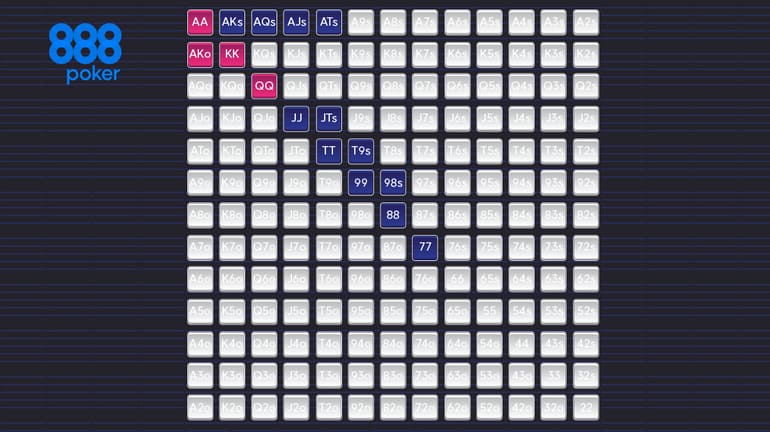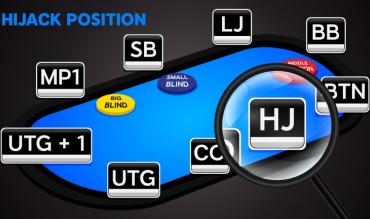This basic guide will provide a strategic outlook when playing in the HJ (hijack). We’ll select examples from NLHE cash games, but many of the concepts will translate into other formats such as tournaments or PLO.
The most profitable scenario is where the action gets folded around to the HJ preflop, allowing us to open raise. Good players look to play about 18% of holdings from this position. It’s difficult to play more aggressively than this due to the ever-present threat of 3bets and cold calls from the CO and BTN.
The Hijack – An Overview
Let’s recap on the key features of the HJ (hijack).
- The first of the “middle positions” on both short-handed and full ring tables.
- Limited access to the blinds due to the presence of the cutoff and button.
- HJ generally faces strong open raising ranges (lojack and earlier).
- Acts fifth from last preflop (our cold calls can easily get overcalled or squeezed).
- We are very likely to be out of position postflop (especially on short-handed tables)
Although open raising is the most profitable HJ scenario, we also have the option to attack open raises from the earlier positions (only lojack in short-handed games) either by cold calling or 3betting. It’s also difficult to play too aggressively in this scenario however since -
1. Our cold calls can easily get squeezed or overcalled by the CO, BTN, SB (small blind) or BB (big blind).
2. Even if we 3bet the CO, BTN, SB, or BB may decide to cold-4bet preflop.
3. Since we are playing against the LJ (lojack) and earlier, we are typically facing a relatively strong opening range.
As such, cold calling and 3betting will be a smaller part of our strategy relative to the CO and BTN.
Strategic Outlook in the HJ
Understand that we are not in a premium seat and follow a reserved strategy. Occasionally look to attack earlier position opens but mostly with premium holdings.
Stats:
Recommended average cold call frequency: Around 6%
Recommended average 3bet frequency: Around 5%
Recommended raise first in frequency: Around 18%
(Remember that these stats account for a range of different open sizings)
Sample Ranges From the HIJACK
HJ Defence vs Lojack Open
Purple: Re-raise (3bet) range
Blue: Cold calling range
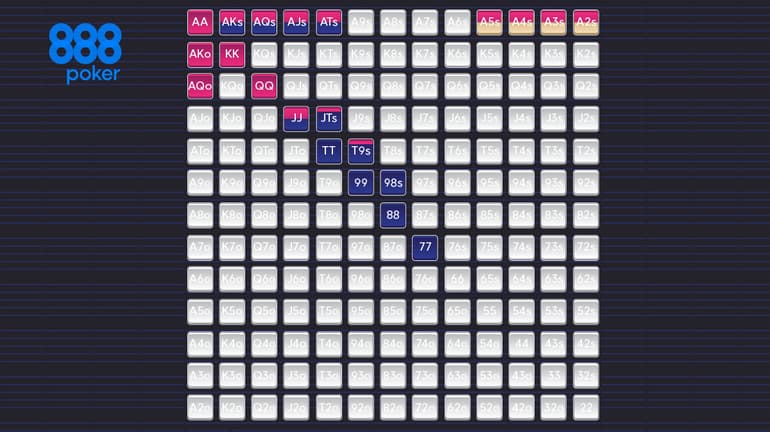
This graph represents a sample range for defending against a LJ 3bb open-raise. If the LJ open-raises smaller we should defend wider, but more on that later. Note that the 3bet (re-raise) range is heavily weighted towards high-equity holdings. It makes sense, not to 3bet bluff speculative holdings in the majority of games since players are not folding as much as they are supposed to when facing 3bets.
HJ Defence vs UTG (FR) Open
Purple: Re-raise (3bet) range
Blue: Cold calling range
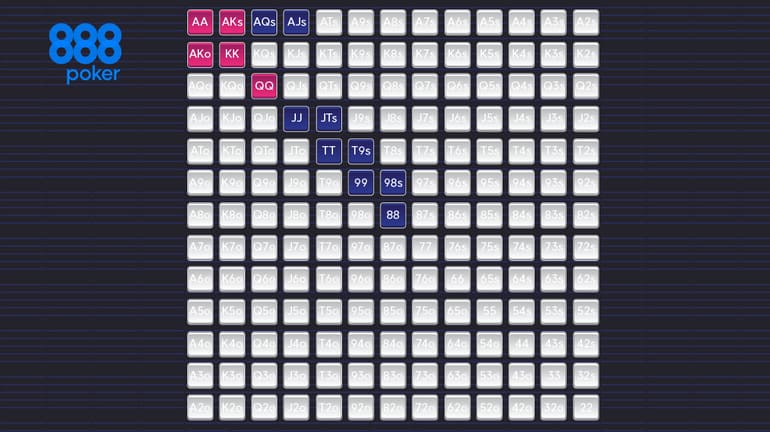
This strategy now assumes that we are playing on a FR table and facing an open from the earliest position. We should defend a tighter range in this spot since the average UTG raise-first-in range will be stronger than the average LJ raise-first-in range.
HJ Raise-First-In Range
“Raise-first-in” means to open-raise preflop after it gets folded around to us. It’s essential to strike an appropriate balance between aggression and reservedness in this seat. Our chance of being able to pick up the blinds is low, but certainly not non-existent.
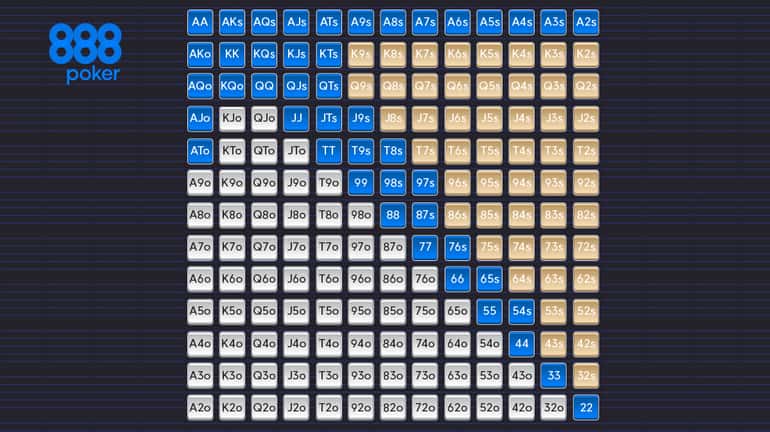
This raising range works out at about 18% of holdings. If we push our aggression beyond this, good players behind may find ways to exploit our strategy.
Having said that, if there are weaker players or big folders behind, some expansion to this default 18% range could be prudent. It’s unlikely the range should ever be wider than 23% or 24%, however, except in particularly extreme circumstances.
HJ vs Blinds 3bet
When open raising from the HJ we are going to run into 3bets. Our response will depend on whether the 3bet comes from the blinds or the BTN/CO. The following sample range gives us an idea regarding what we should call and what we should re-raise (4bet) when facing a 3bet from the blinds.
Blue = Call vs 3bet
Purple = Re-raise (4bet) vs 3bet
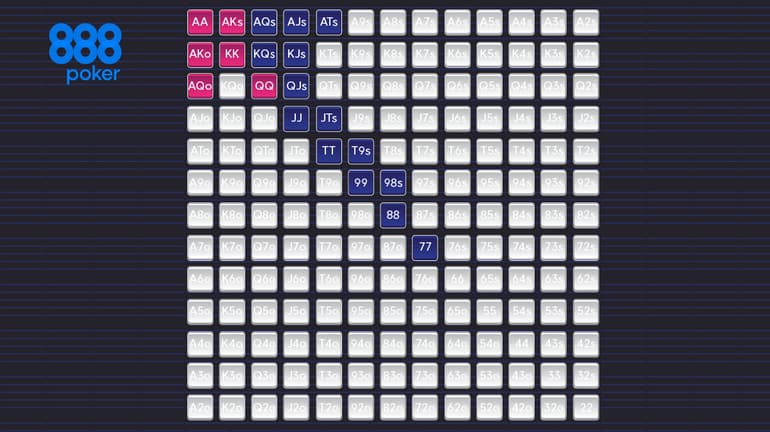
Note that we tend towards re-raise (4betting) with high equity hands only. 4bet bluffing is not incentivised in most environments since the average Villain does not fold as much as they are supposed to vs 4bets. Assuming the 3better is on the BTN/CO rather than in the blinds, we should look to respond with a tighter range.
Blue = Call vs 3bet
Purple = Re-raise (4bet) vs 3bet
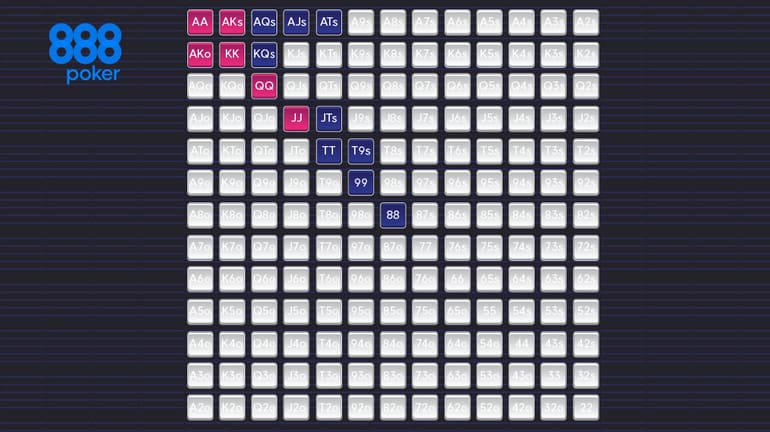
Relevant Adjustments
It’s crucial to understand that the sample ranges should be used as a rough guide rather than a set rule. In practice, we will end up changing these defending ranges based on a several variables. A good understanding of these variables will help us to make high-quality decisions on the fly.
Villain’s sizing – The larger our opponent’s open raise (or 3bet) sizing, the tighter we defend.
Formation – The later our opponent’s position, the wider we can defend.
Reads – E.g. our opponent folds too much to 3bets/4bets, we can 3bet/4bet more aggressively.
Villain skill - If our opponent is a bad player, we can play more hands in general.
Open-raises – If the players behind fold too much or are weak players, we can slightly expand our raise-first-in range.
Other Scenarios
Iso Raising – This situation occurs when we raise from the HJ, facing an open-limp. Since there are four players still to act behind us, we can only push our iso-raising strategy so wide even if we think Villain is a highly profitable target.
Our iso raising range will be somewhat similar to our raise-first-in range from this seat but weighted more towards high equity holdings.
Iso-raise – A preflop raise made against a limper.
Overcall – A call after a player has already called before us on the current street.
Squeeze – A 3bet made after there has already been at least one caller vs an open raise.
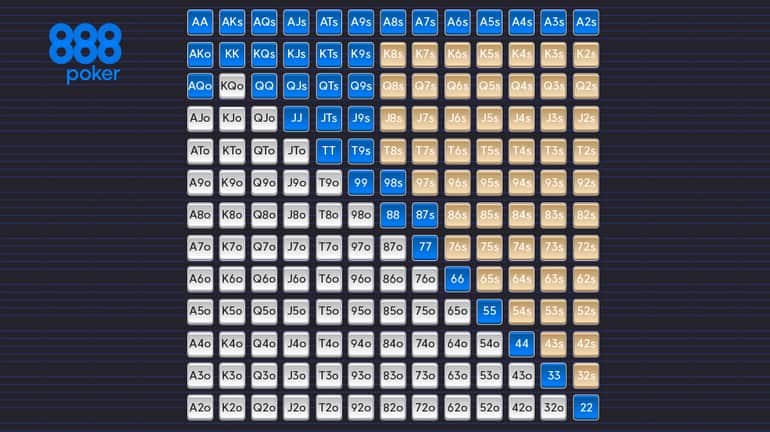
Overcalling/Squeezing – Overcalling and squeezing are terms which refer to 3-way scenarios. When facing two opponents, we generally prefer to 3bet (squeeze) a tighter range and weight our calls (overcall) towards speculative hands with good suited/connected potential.
Note: squeezing and overcalling from this spot is ONLY possible on full ring tables.
For the sake of comparison, here is what a HJ squeezing/overcalling range might look like when facing an early position open (FR) and call.
Purple: Re-raise (squeeze) range
Blue: Overcalling range
